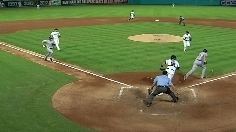 | ||
In baseball, the squeeze play (a.k.a. squeeze bunt) is a maneuver consisting of a sacrifice bunt with a runner on third base. The batter bunts the ball, expecting to be thrown out at first base, but providing the runner on third base an opportunity to score. Such a bunt is uncommon with two outs because there is a significant chance that the batter would be thrown out at first base, ending the inning. Likewise, such an attempt is unlikely with two strikes because a bunt that is fouled off with two strikes is an automatic strike out. The squeeze play is said to have been invented during a college game at Yale University by Dutch Carter and George B. Case.
In a safety squeeze, the runner at third does not take off until the batter makes contact bunting, waiting for more certainty that the ball will go to a location from which it will be difficult for the fielding team to make an out at home plate.
In a suicide squeeze, the runner takes off as soon as the pitcher begins to throw the pitch, before releasing the ball. If properly executed, a play at home plate is extremely unlikely. However, if the batter fails to make contact with the pitch, the runner is likely to be put out at home plate (hence, "suicide"). Therefore, the suicide squeeze usually requires a skilled bunter who can make contact consistently, even on difficult pitches.
These plays are often used in the late innings of a close game in order to score a tying, winning, or insurance run.
